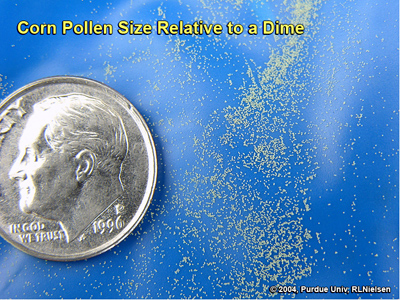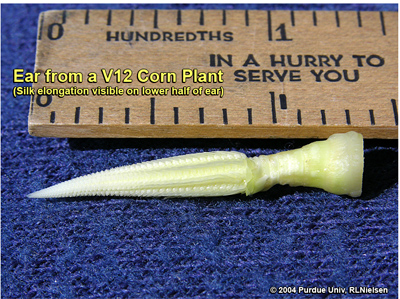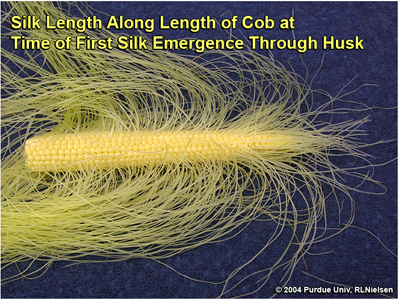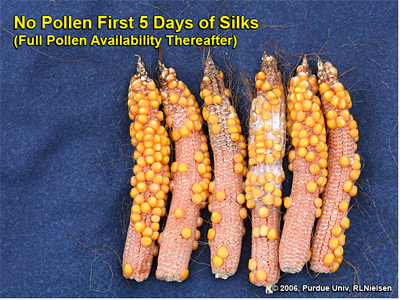Mesotrione Carryover into Soybean - (Glenn Nice and Bill Johnson)
Mesotrione, an active ingredient found in Callisto, Lumax, Lexar, and Halex provides excellent preemergence control of black nightshade, lambsquarter, pigweeds, annual smartweeds, velvetleaf and waterhemp. It also provides excellent postemergence control of these weeds and several others. It is labeled for preemergence and in come cases postemergence in corn. Mesotrione is an HPPD inhibitor or a group 27 herbicide that causes bleaching in susceptible weeds. Our own weed guide gives a good tolerance rating for mesotrione for corn. In rare cases it has been reported to carry over into soybean.
In the 2004 Weed Control update we reported on a few cases of mesotrione carryover injury to soybean in North East Indiana [1]. In these cases injury was most prevalent on sandy soils with low organic matter and low CEC. The soil pH was often reported to be low, below 6.0. The conditions leading up to carryover are not completely understood. Mike Owen of Iowa State University suggested that they occurred in areas where overlap could have taken place added to this that the summer of application was dry and they experienced a cold wet spring [2].
Mesotrione is broken down in the soil by microbial activity into an end product of CO2. Any soil quality that would inhibit microbial activity, such as dry conditions or changes in pH, could potentially lead to a decrease in the breakdown of the herbicides. Of course, doubling up on rates due to overlapping or improper calibration of spray equipment would also lead to a higher potential for carryover. In 2008, Darren Robinson of the University of Guelph reported that the addition of atrazine increased injury in horticulture crops planted one year after a mesotrione application.
In cases where mesotrione carryover is suspected, symptoms observed on soybean are bleaching of the tips and margins of new growth (figure 1). This bleaching often bleaches out the veins or causes a mottling effect (figure 1). In cases where drift is the suspected delivery method, bleaching of the veins and mottling is not as evident. In a carryover situation the introduced herbicide is taken up from the soil and if the herbicide is soluble in water it moved into the leaf to accumulate in the tips and margins. Oddly enough, in some cases the leaves may have a slight strapping effect (figure 2). Strapping is typically connected to growth regulator herbicide injury, but in these cases of possible mesotrione carryover new growth may show a strapping effect. In some of the cases it has not always been clear if the injured soybean may have also come in contact with a growth regulator; however, in all cases a HPPD inhibitor was used the previous year and there are no reports of growth regulator herbicides causing a bleaching effect.
Figure 1. Bleaching and mottling effect in soybean leaves. (Photo Credit: Glenn Nice)
Figure 2. Bleaching and strapping effect in soybean leaves. (Photo Credit: Glenn Nice)
In most cases soybean appear to grow out of this and yield is not greatly impacted. I could not find any reports indicating yield was impacted by mesotrione carryover. In the cases reported in 2004 no yield effects were reported.
In a study conducted by Bryan Young at the Southern Illinois University mesotrione was applied over the top of soybean [3]. A 7 oz/A application of Callisto provides 0.2 lb ai/A of mesotrione. In the above study mesotirone was put out at 0.5, 1.5, 5, 15 and 45% of the 0.2 lb ai/A rate. All rates were reported to cause injury. Injury reported were "bleaching, necrosis, and malformation." Suggesting that the strapping symptomology mentioned above is not completely unsubstantiated. The 15 and 45% rates induced 31 to 66% injury respectively, 28 days after treatment. At 56 days after treatment injury was 6% or less from all rates except the highest. At the lower rates soybean was able to bounce back having no yield impacts when compared to a non treated check. The two highest rates with 31 and 66% injury at 28 days after treatment were also reported to decrease yield 11 and 22% respectively.
Mesotrione and other HPPD inhibitors are valuable tools for weed management in corn. Callisto's rotation restriction for planting soybean is 10 months and for the most part this is sufficient to assure that the herbicide has broken down enough to have no impact on the following years soybean. Oddly enough, nature and human error has a way of providing eloquent scenarios that can lead to products that typically do the job they were intended for with no implications to bite us a bit.
1. Herbicide Update. 2004. Bill Johnson, Glenn Nice and Tom Bauman. Purdue University <http://www.btny.purdue.edu/weedscience/2004/articles/update04.pdf>.
2. Mesotrione Carryover to Soybean. 2004. Mike Owen. Iowa State University. <http://www.ipm.iastate.edu/ipm/icm/2004/7-12-2004/mesotrione.html>.
3. Soybean (Glycine max) Response to Foliar Applications of Mesotrione. 2003. Bryan G. Young, Julie M. Young, Joseph L. Matthews. Weed Technology, Vol. 17, No. 4 pp. 651-654.
![]()
Tassel Emergence & Pollen Shed – (Bob Nielsen)
•Corn produces individual male and female flowers on the same plant.
•The tassel represents the male flower of the corn plant.
Depending on the year, Indiana's corn crop typically enters the critical flowering stages of pollen shed and silk emergence sometime between late June to late July. Success or failure during this period of the corn plant's life greatly influences the potential grain yield at harvest time.
As important as this process is to the determination of grain yield, it is surprising how little some folks know about the whole thing. Rather than leaving you to learn about such things "in the streets", I've developed this article and the accompanying one on silking (Nielsen, 2010) that describe the ins and outs of sex in the corn field.
Remember that corn has both male flowers and female flowers on the same plant (a flowering habit called monoecious for you trivia fans.) Interestingly, both flowers are initially bisexual (aka "perfect"), but during the course of development the female components (gynoecia) of the male flowers and the male components (stamens) of the female flowers abort, resulting in tassel (male) and ear (female) development.
Growth Stage VT (Tasseling)
Portions of the tassel may be visible before the plant technically reaches the last leaf stage (final visible leaf collar) has occurred. By definition, growth stage VT occurs when the last branch of the tassel emerges from the whorl (Ritchie et. al., 1993). This authoritative source furthermore stated that growth stage VT is "initiated when the last branch of the tassel is completely visible and the silks have not yet emerged." Once upon a time, that exact developmental sequence may have been true, but today's hybrids tend to behave differently. It is not uncommon for silk emergence to begin not only prior to the last tassel branch appearing from the whorl, but also prior to the exsertion of anthers and pollen shed (Nielsen, 2009).
Plant height reaches its maximum at or shortly after growth stage VT as the final stalk internodes complete their elongation. The corn plant is most vulnerable to hail damage at growth stage VT because all of its leaves are exposed. Complete (100 %) leaf loss at growth stage VT will usually result in complete (100 %) yield loss by harvest. Even if pollination results in successful fertilization of the ovules, entire ear shoots will usually die because so few leaves remain to produce the necessary carbohydrates (by photosynthesis) to complete grain fill.
Tassel Morphology
Approximately 1,000 individual spikelets form on each tassel and each one bears two florets encased in two large glumes. Each floret contains three anthers. An anther and its attached filament comprise the stamen of the male flower. The anthers are those "thingamajigs" that hang from the tassel during pollination. Under a magnifying lens, anthers look somewhat like the double barrel of a shotgun. Do the math and you will realize that an individual tassel produces approximately 6,000 pollen-bearing anthers, although hybrids can vary greatly for this number.
As these florets mature, elongation of the filaments helps exsert the anthers from the glumes. Pollen is dispersed through pores that open at the tips of the anthers. Pollen shed usually begins in the mid-portion of the central tassel spike and then progresses upward, downward and outward over time. Anthers typically emerge from the upper floret of the pair first, while those from lower floret typically emerge later the same day or on following days. Spent anthers eventually drop from the tassel and are sometimes mistaken for the pollen when observed on the leaves or ground.
Exserted anthers on a tassel
Closeup of anthers
Exserted anthers on a tassel
Closeup of anthers
Corn pollen size relative to a dime
The yellow or white "dust-like" pollen that falls from a tassel represents millions of individual, nearly microscopic, spherical, yellowish- or whitish translucent pollen grains. Estimates of the total number of pollen grains produced per tassel range from 2 to 25 million. Each pollen grain contains the male genetic material necessary for fertilizing the ovary of one potential kernel.
The outer membrane of a pollen grain is very thin. Once dispersed into the atmosphere, pollen grains remain viable for only a few minutes before they desiccate. Yet, with only a 15 mph wind, pollen grains can travel as far as 1/2 mile within those couple of minutes.
Therein lies the concern of the potential for pollen "drift" from a transgenic corn field to an adjacent non-transgenic corn field and the risk of transgenic "contamination" of grain intended for non-transgenic markets. The good news is that recent research suggests that the overwhelming majority of a corn field's pollen load is shed in the field itself.
All of the pollen from a single anther may be released in as little as three minutes. All the anthers on an individual tassel may take as long as seven days to finish shedding pollen, although the greatest volume of pollen is typically shed during the second and third day of anther emergence. Because of natural field variability in plant development, a whole field may take as long as 14 days to complete pollen shed.
Peak pollen shed usually occurs in mid-morning. Some research indicates that pollen shed decreases after temperatures surpass 86°F. A second "flush" of pollen often occurs in late afternoon or evening as temperatures cool. Pollen shed may occur throughout most of the day under relatively cool, cloudy conditions.
Weather conditions influence pollen shed. If the anthers are wet, the pores will not open and pollen will not be released. Thus, on an average Indiana summer morning following a heavy evening dew, pollen shed will not begin until the dew dries and the anther pores open. Similarly, pollen is not shed during rainy conditions. Cool, humid temperatures delay pollen shed, while hot, dry conditions hasten pollen shed.
Extreme heat stress (100°F or greater) can kill corn pollen, but fortunately the plant avoids significant pollen loss by virtue of two developmental characteristics. First of all, corn pollen does not mature or shed all at once. Pollen maturity and shed occur over several days and up to two weeks. Therefore, a day or two of extreme heat usually does not affect the entire pollen supply. More importantly, the majority of daily pollen shed occurs in the morning hours when air temperature is much more moderate.
Related Reading
Kling, Jennifer G. and Gregory Edmeades. 1997. Morphology and growth of maize. IITA/CIMMYT Research Guide 9. Int'l Institute of Tropical Agriculture. [On-Line}. Available at <http://www.iita.org/cms/details/trn_mat/irg9/irg9.htm> [URL accessed July 2010].
Nielsen, RL (Bob). 2007. A Fast & Accurate Pregnancy Test for Corn. Corny News Network, Purdue Univ. [On-Line]. Available at <http://www.kingcorn.org/news/timeless/EarShake.html> [URL accessed July 2010].
Nielsen, RL (Bob). 2009. Unusually long silks in corn. Corny News Network, Purdue Univ. [online] <http://www.kingcorn.org/news/timeless/LongSilks.html> [URL accessed July 2010].
Nielsen, RL (Bob). 2010. Silk Emergence. Corny News Network, Purdue Univ. [On-Line]. Available at <http://www.kingcorn.org/news/timeless/Silks.html> [URL accessed July 2010].
Ritchie, S.W., J.J. Hanway, and G.O. Benson. 1993. How a Corn Plant Develops. Iowa State Univ. Sp. Rpt. No. 48. [On-Line]. Available at <http://www.extension.iastate.edu/hancock/info/corn.htm> [URL accessed July 2010].
Russell, W.A. and A.R. Hallauer. 1980. Corn. (a chapter in) Hybridization of Crop Plants. American Soc. of Agronomy-Crop Science Soc. of America. Madison, WI.
![]()
Silk Development and Emergence in Corn – (Bob Nielsen)
- Corn produces individual male and female flowers on the same plant.
- The ear represents the female flower of the corn plant.
- Severe soil moisture deficits can delay silk emergence and disrupt the synchrony of pollen shed and silk availability, resulting in poor kernel set.
The corn plant produces individual male and female flowers (a flowering habit called monoecious for you corny trivia fans.) Interestingly, both flowers are initially bisexual (aka "perfect"), but during the course of development the female components (gynoecia) of the male flowers and the male components (stamens) of the female flowers abort, resulting in tassel (male) and ear (female) development.
The silks that emerge from the ear shoot are the functional stigmas of the female flowers of a corn plant. Each silk connects to an individual ovule (potential kernel). A given silk must be pollinated in order for the ovule to be fertilized and develop into a kernel. Up to 1000 ovules typically form per ear, even though we typically harvest only 400 to 600 actual kernels per ear.
Technically, growth stage R1 (Ritchie et. al., 1993) for a given ear is defined when a single silk strand is visible from the tip of the husk. A field is defined as being at growth stage R1 when silks have emerged on at least 50 % of the plants. This whole field definition for growth stage R1 is synonymous with the term "mid-silk".
Silk Elongation and Emergence
Silks begin to elongate from the ovules 10 to 14 days prior to growth stage R1 or approximately at the V12 leaf stage. Silk elongation begins first from the basal ovules of the cob, then proceeds sequentially up the ear. Because of this acropetal sequence of silk elongation, silks from the basal (butt) portion of the ear typically emerge first from the husk, while the tip silks generally emerge last. Complete silk emergence from an ear generally occurs within four to eight days after the first silks emerge from the husk leaves.
As silks first emerge from the husk, they lengthen as much as 1.5 inches per day for the first day or two, but gradually slow over the next several days. Silk elongation occurs by expansion of existing cells, so elongation rate slows as more and more cells reach maximum size. Elongation of an individual silk stops shortly after pollen is captured, germinates and then penetrates the silk.
If not pollinated, silk elongation stops about 10 days after silk emergence due to senescence of the silk tissue. Unusually long silks can be a diagnostic symptom that the ear was not successfully pollinated.
Silks remain receptive to pollen grain germination up to 10 days after silk emergence, but to an ever-decreasing degree. The majority of successful ovule fertilization occurs during the first 4 to 5 days after silk emergence (see photos that follow).
Natural senescence of silk tissue over time results in collapsed tissue that restricts continued growth of the pollen tube. Silk emergence usually occurs in close synchrony with pollen shed, so that duration of silk receptivity is normally not a concern. Failure of silks to emerge in the first place, however, does not bode well for successful pollination.
Pollination and Fertilization
For those of you serious about semantics, let's review two definitions relevant to sex in the cornfield. Pollination is the act of transferring the pollen grains to the silks by wind or insects. Fertilization is the union of the male gametes from the pollen with the female gametes from the ovule. Technically, pollination is almost always successful (i.e., the pollen reaches the silks), but unsuccessful fertilization (i.e., pollen tube failure, silk failure, pollen death) will fail to result in a kernel.
Pollen grain germination occurs within minutes after a pollen grain lands on a receptive silk. A pollen tube, containing the male genetic material, develops and grows inside the silk, and fertilizes the ovule within 24 hours. Pollen grains can land and germinate anywhere along the length of an exposed receptive silk. Many pollen grains may germinate on a receptive silk, but typically only one will successfully fertilize the ovule.
Silk Emergence Failure
Severe Drought Stress. The most common cause of incomplete silk emergence is severe drought stress. Silks have the greatest water content of any corn plant tissue and thus are most sensitive to moisture levels in the plant. Severe moisture deficits will slow silk elongation, causing a delay or failure of silks to emerge from the ear shoot. If the delay is long enough, pollen shed may be almost or completely finished before receptive silks are available; resulting in nearly blank or totally blank cobs. Severe drought stress accompanied by low relative humidity can also desiccate exposed silks and render them non-receptive to pollen germination.
The severity of drought stress required for significant silk emergence delay or desiccation can probably be characterized by severe leaf rolling that begins early in the morning and continues into the early evening hours. Such severe leaf rolling is often accompanied by a change in leaf color from "healthy" green to a grayish-tinged green that may eventually die and bleach to a straw color.
Silk Clipping by Insects. Although technically not described as silk emergence failure, severe silk clipping by insects such as corn rootworm beetle or Japanese beetle nonetheless can interfere with the success of pollination by decreasing or eliminating viable or receptive exposed silk tissue. Fortunately, unless the beetle activity is nonstop for days, continued elongation of silks from the husk will expose undamaged and receptive silk tissue at the rate of about one inch or more per day.
Silk elongation on the lower half of a V12 ear shoot; 10 to 14 days before silk emergence
Silk elongation on the lower 2/3 of a V14 ear shoot; about 4 days after V12; 6 to 10 days before silk emergence
Variable silk length along length of cob at first silk emergence; illustrating the acropetal developmet of silks
Appearance of silks recently clipped using knife; note the damaged, non-receptive ends of the clipped silks
About 1.5 inches of silk elongation since being manually clipped about 15 hrs. previous
Trichomes visible on silks just emerging through husk leaves
Kernel set on ears where pollination was prevented for 3 days after first silk emergence, then allowed to proceed without interference
Kernel set on ears where pollination was prevented for 5 days after first silk emergence, then allowed to proceed without interference
Related Reading
Kling, Jennifer G. and Gregory Edmeades. 1997. Morphology and growth of maize. IITA/CIMMYT Research Guide 9. Int'l Institute of Tropical Agriculture. [On-Line}. Available at <http://www.iita.org/cms/details/trn_mat/irg9/irg9.htm> [URL accessed July 2010].
Nielsen, R.L. (Bob). 2007. A Fast & Accurate Pregnancy Test for Corn. Corny News Network, Purdue Univ. [On-Line]. Available at <http://www.kingcorn.org/news/timeless/EarShake.html> [URL accessed July 2010].
Nielsen, R.L. (Bob). 2010. Tassel Emergence & Pollen Shed. Corny News Network, Purdue Univ. [On-Line]. Available at <http://www.kingcorn.org/news/timeless/Tassels.html> [URL accessed July 2010].
Purdue Univ. 2010. Corn Rootworms. Entomology Dept, Purdue Univ. [online] <http://extension.entm.purdue.edu/fieldcropsipm/insects/corn-rootworms.php> [URL accessed July 2010].
Ritchie, S.W., J.J. Hanway, and G.O. Benson. 1993. How a Corn Plant Develops. Iowa State Univ. Sp. Rpt. No. 48. [On-Line] Available at <http://www.extension.iastate.edu/hancock/info/corn.htm> [URL accessed July 2010].
Russell, W.A. and A.R. Hallauer. 1980. Corn. (a chapter in) Hybridization of Crop Plants. American Soc. of Agronomy-Crop Science Soc. of America. Madison, WI.
Steffey, Kevin. 2005. Rootworm Adults and Silk Clipping. Pest & Crop Bulletin, Univ. of Illinois. [On-Line]. Available at <http://bulletin.ipm.illinois.edu/article.php?id=352> [URL accessed July 2010].
![]()
Click here to see the Black Light Trap Catch Report
![]()
Click here to see the Western Bean Cutworm Adult Pheromone Trap Report
![]()


















